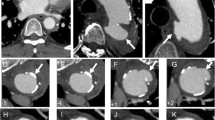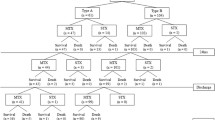Abstract
There has been continuing discussion regarding the treatment strategy for acute type A intramural hematoma (IMH). Most patients are treated conservatively in Japan; hence, predicting fatal events and stratifying risks based on results normally obtained on hospital arrival are important. We aimed to examine the incidences and risk factors of death or need for surgery for acute type A IMH in patients receiving medical treatment and to identify high-risk patients using clinical findings on hospital arrival. From 2011 to 2016, 57 consecutive patients (mean age 72.5 years; male 36.8%) diagnosed with acute type A IMH who were receiving treatment at Shizuoka City Shizuoka Hospital were retrospectively included. Primary endpoint was a composite of cardiovascular death and operation within 1 year after onset. To evaluate sensitivity and specificity of the risk factors and risk score, we estimated the area under the receiver operating characteristic (ROC) curve. Mean follow-up duration was 621 days. Mean systolic blood pressure (SBP) was 129 mmHg. Computed tomography (CT) on arrival showed a mean ascending aorta diameter of 46 mm. Ulcer-like projection (ULP) in the ascending aorta and pericardial effusion (PE) were seen in 33% and 42% of cases, respectively. Twenty-eight patients (49.1%) reached the primary endpoint (cardiovascular death, 7 cases [12.3%]; operation, 21 cases [36.8%]). In univariate analysis of admission values, the primary endpoint group had significantly lower SBP (113.0 ± 28.5 vs 144.3 ± 33.5 mmHg), higher ascending aorta diameter (49.5 ± 8.1 vs 43.6 ± 5.9 mm), and higher frequency of ULP (53.8% vs 13.8%) and PE (58.6% vs 25.0%) than the event-free group. Multivariate analysis showed that ULP on admission CT was a significant predictor of the primary endpoint. The risk score was considered using these risk factors. On admission, the primary endpoint could be predicted with 89.7% sensitivity and 75% specificity (area under the ROC curve 0.823) if the patient had ULP and/or > 2 of the following factors: SBP < 120 mmHg, ascending aorta diameter > 45 mm, and PE. SBP and CT findings on arrival were significantly associated with cardiovascular death and the need for surgery in patients with acute type A IMH receiving initial medical therapy. The novel risk score was useful for predicting cardiovascular death and surgery.



Similar content being viewed by others
References
Okita Y (2016) Current surgical results of acute type A aortic dissection in Japan. Ann Cardiothorac Surg 5:368–376
Hiratzka LF, Bakris GL, Beckman JA, Bersin RM, Carr VF, Casey DE Jr, Eagle KA, Hermann LK, Isselbacher EM, Kazerooni EA, Kouchoukos NT, Lytle BW, Milewicz DM, Reich DL, Sen S, Shinn JA, Svensson LG, Williams DM, American College of Cardiology Foundation/American Heart Association Task Force on Practice Guidelines, American Association for Thoracic Surgery, American College of Radiology, American Stroke Association, Society of Cardiovascular Anesthesiologists, Society for Cardiovascular Angiography, and Interventions, Society of Interventional Radiology, Society of Thoracic Surgeons, Society for Vascular Medicine (2010) ACCF/AHA/AATS/ACR/ASA/SCA/SCAI/SIR/STS/SVM guidelines for the diagnosis and management of patients with thoracic aortic disease: a report of the American College of Cardiology Foundation/American Heart Association Task Force on practice guidelines, American Association for Thoracic Surgery, American College of Radiology, American Stroke Association, Society of Cardiovascular Anesthesiologists, Society for Cardiovascular Angiography and Interventions, Society of Interventional Radiology, Society of Thoracic Surgeons, and Society for Vascular Medicine. Circulation 121:e266–e369
Erbel R, Aboyans V, Boileau C, Bossone E, Bartolomeo RD, Eggebrecht H, Evangelista A, Falk V, Frank H, Gaemperli O, Grabenwöger M, Haverich A, Iung B, Manolis AJ, Meijboom F, Nienaber CA, Roffi M, Rousseau H, Sechtem U, Sirnes PA, Allmen RS, Vrints CJ, ESC Committee for Practice Guidelines (2014) 2014 ESC guidelines on the diagnosis and treatment of aortic diseases: document covering acute and chronic aortic diseases of the thoracic and abdominal aorta of the adult. The task force for the diagnosis and treatment of aortic diseases of the European Society of Cardiology (ESC). Eur Heart J 35:2873–2926
JCS Joint Working Group (2013) Guidelines for diagnosis and treatment of aortic aneurysm and aortic dissection (JCS 2011): digest version. Circ J 77:789–828
Kitai T, Kaji S, Yamamuro A, Tani T, Tamita K, Kinoshita M, Ehara N, Kobori A, Nasu M, Okada Y, Furukawa Y (2009) Clinical outcomes of medical therapy and timely operation in initially diagnosed type A aortic intramural hematoma: a 20-year experience. Circulation 120:S292–S298
Song JK, Yim JH, Ahn JM, Kim DH, Kang JW, Lee TY, Song JM, Choo SJ, Kang DH, Chung CH, Lee JW, Lim TH (2009) Outcomes of patients with acute type A aortic intramural hematoma. Circulation 120:2046–2052
Sadamatsu K, Takase S, Sagara S, Ohe K, Nishi JI, Tashiro H, Kosuga T, Yasunaga H (2018) Initial medical management in acute type A aortic dissection patients with a thrombosed false lumen in the ascending aorta combining intramural hematoma and retrograde dissection from the descending to the ascending aorta. Eur Heart J Acute Cardiovasc Care. https://doi.org/10.1177/2048872618777724
Tsai TT, Nienaber CA, Eagle KA (2005) Acute aortic syndromes. Circulation 112:3802–3813
Evangelista A, Isselbacher EM, Bossone E, Gleason TG, Eusanio MD, Sechtem U, Ehrlich MP, Trimarchi S, Braverman AC, Myrmel T, Harris KM, Hutchinson S, O'Gara P, Suzuki T, Nienaber CA, Eagle KA, IRAD Investigators (2018) Insights from the international registry of acute aortic dissection: a 20-year experience of collaborative clinical research. Circulation 137:1846–1860
Di Eusanio M, Trimarchi S, Patel HJ, Hutchison S, Suzuki T, Peterson MD, Di Bartolomeo R, Folesani G, Pyeritz RE, Braverman AC, Montgomery DG, Isselbacher EM, Nienaber CA, Eagle KA, Fattori R (2013) Clinical presentation, management, and short-term outcome of patients with type A acute dissection complicated by mesenteric malperfusion: observations from the International Registry of Acute Aortic Dissection. J Thorac Cardiovasc Surg 145:385–390
Hagan PG, Nienaber CA, Isselbacher EM, Bruckman D, Karavite DJ, Russman PL, Evangelista A, Fattori R, Suzuki T, Oh JK, Moore AG, Malouf JF, Pape LA, Gaca C, Sechtem U, Lenferink S, Deutsch HJ, Diedrichs H, Marcos y Robles J, Llovet A, Gilon D, Das SK, Armstrong WF, Deeb GM, Eagle KA (2000) The International Registry of Acute Aortic Dissection (IRAD): new insights into an old disease. JAMA 283:897–903
Hayashi H, Matsuoka Y, Sakamoto I, Sueyoshi E, Okimoto T, Hayashi K, Matsunaga N (2000) Penetrating atherosclerotic ulcer of the aorta: imaging features and disease concept. Radiographics 20:995–1005
Evangelista A, Mukherjee D, Mehta RH, O’Gara PT, Fattori R, Cooper JV, Smith DE, Oh JK, Hutchison S, Sechtem U, Isselbacher EM, Nienaber CA, Pape LA, Eagle KA, International Registry of Aortic Dissection (IRAD) Investigators (2005) Acute intramural hematoma of the aorta: a mystery in evolution. Circulation 111:1063–1070
Harris KM, Braverman AC, Eagle KA, Woznicki EM, Pyeritz RE, Myrmel T, Peterson MD, Voehringer M, Fattori R, Januzzi JL, Gilon D, Montgomery DG, Nienaber CA, Trimarchi S, Isselbacher EM, Evangelista A (2012) Acute aortic intramural hematoma: an analysis from the International Registry of Acute Aortic Dissection. Circulation 126:S91–S96
Pérez-Casares A, Cesar S, Brunet-Garcia L, Sanchez-de-Toledo J (2017) Echocardiographic evaluation of pericardial effusion and cardiac tamponade. Front Pediatr 5:79
Acknowledgements
We thank the staff and participants of the study. We are also grateful to the cardiovascular surgeons in our institute for giving us the opportunity to treat and diagnose challenging cases as well as for providing important suggestions.
Funding
This research received no specific grant from any funding agency in the public, commercial, or not-for-profit sectors.
Author information
Authors and Affiliations
Contributions
Conception and design of study: SK; Acquisition of data: SK and HM; Analysis and/or interpretation of data: SK, and HM; Drafting the manuscript: SK; Revising the manuscript critically for important intellectual content: TO, RN, and KM; Approval of the version of the manuscript to be published: SK, HM, AN, KK, YH, YW, HS, MK, RT, KM, RN, and TO.
Corresponding author
Ethics declarations
Conflict of interest
The authors declare that they have no conflict of interest.
Ethical approval
The study was conducted in accordance with the Helsinki Declaration and was approved by the institutional review board (19-02).
Informed consent
Obtaining informed consent from the participants was not required.
Additional information
Publisher's Note
Springer Nature remains neutral with regard to jurisdictional claims in published maps and institutional affiliations.
Electronic supplementary material
Below is the link to the electronic supplementary material.
Rights and permissions
About this article
Cite this article
Kageyama, S., Mitake, H., Nakajima, A. et al. A novel risk score on admission for predicting death or need for surgery in patients with acute type A intramural hematoma receiving medical therapy. Heart Vessels 35, 1164–1170 (2020). https://doi.org/10.1007/s00380-020-01583-3
Received:
Accepted:
Published:
Issue Date:
DOI: https://doi.org/10.1007/s00380-020-01583-3




